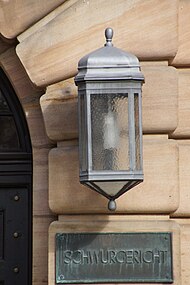Jury court
A jury trial , one with full-time judges and lay judges occupied Criminal Court , which is responsible for very serious offenses, in Germany , a first-instance Chamber of the District Court , whose jurisdiction for the completed and attempted offenses of murder , of manslaughter and for all with the death of the income qualified homicides given is. The responsibility does not exist if after § 120 GVG the Oberlandesgericht in the first instance is responsible. It is only competent in criminal cases against adults; The large youth chamber is responsible for young people and adolescents.
Like a large criminal chamber , the jury is made up of three professional judges and two lay judges ( Section 76 (2) sentence 3 number 1 GVG). A cast reduction is excluded. The difference to the criminal chamber is the special jurisdiction for offenses which show an outstanding gravity of the guilt and the consequences of the offense and which are particularly worthy of condemnation. This responsibility is laid down in Section 74 (2) and Section 74e GVG.
In principle, all members have the same weight and the same rights in negotiations, advice and voting. However, the lay judges do not participate in procedural decisions outside the main proceedings .
The presiding judge , who belongs to the professional judges, has a prominent position, since he is entitled to lead the hearing and the priority hearing of the accused and the witnesses before the cross-examination , the taking of evidence and the recording of the minutes . It decides on the admissibility of questions to the witnesses, on requests and objections, initially alone; in the event of an objection to the decision, the chamber decides on this. The chairman is also responsible for the special protection of victims who are questioned as witnesses and witnesses whose anonymity must be preserved. In particular, he can conduct the interrogation of underage victims of sexual offenses alone.
At least one criminal chamber must be set up as a jury court at each regional court, unless the federal states make use of concentration in accordance with Section 74d GVG, so that the jury court at a specific regional court is also responsible for corresponding cases from other regional court districts. For proceedings referred back for revision, a catch criminal chamber must also be determined to renegotiate these proceedings. In the case of a particularly large business case, this catch criminal chamber can also act in the first instance.
A revision ( § 333 StPO ) to the Federal Court of Justice ( § 135 paragraph 1 GVG) is given against judgments of the jury court . The Higher Regional Court ( Section 120 (4) GVG) is responsible for complaints ( Section 304 StPO) against other decisions in the proceedings .
history
The term jury court originates from the time after the establishment of the Reich 1871 to 1924, when the jury court was actually still a jury court . It was introduced in 1879 as a lay court with twelve jurors and three professional judges . According to the court rules that were customary until 1924, the judges' bench and jury bench were separate, with the jury deciding on the question of guilt without the judge and judging the sentence with the judges. This practice was abolished under Reich Justice Minister Erich Emminger as part of his controversial judicial reform, the so-called "Emminger-Novelle", in favor of a uniform bench of three professional judges and six jurors (with lay judges) by decree of January 4, 1924. The latter were further reduced in the following period.
In Bavaria after the Second World War there were jury courts of the old type again for a short time, in which the occupation from before 1924 and the separation of the decision on guilt and sentence were restored. This peculiarity ended with the entry into force of the (federal) law to restore legal unity on October 1, 1950.
Up until the Criminal Procedure Amendment Act of 1979, jury courts in the Federal Republic of Germany were still standing arbors of the regional courts with jurisdiction over capital offenses , since then they have been regarded as a special chamber formed by judges and lay judges working at the regional courts on a case-by-case basis for particularly serious capital offenses .
Today the jury no longer decides by jury. In this respect, the name only has historical significance. Material differences to the otherwise competent Grand Criminal Chamber are therefore no longer associated with the repeal of Sections 79 to 92 GVG, with the exception of the compulsory appointment of three professional judges and two lay judges (see, on the other hand, the possibility of a reduced composition of the Large Criminal Chamber according to Section 76 (2) GVG with only two professional judges and two lay judges). There is still a peculiarity with regard to the distribution of business, since there is only one jury court at most regional courts and this criminal chamber is therefore assigned all jury cases.
In the past, criminal press cases were also within the jurisdiction of the jury court.
Web links
Individual evidence
- ↑ Duden: jury court .
- ↑ § 12 Ordinance on the Constitution of Courts and the Administration of Criminal Justice (RGBl. I 1924, p. 15) , accessed on June 25, 2013.
- ^ Ordinance on the reintroduction of jury courts v. July 14, 1948 (BayGVBl p. 243) , accessed on April 30, 2019.
- ↑ v. September 20, 1950 (Federal Law Gazette p. 455) , accessed on April 30, 2019.
- ↑ Criminal Procedure Amendment Act of 1979 on dipbt.bundestag.de (PDF).
